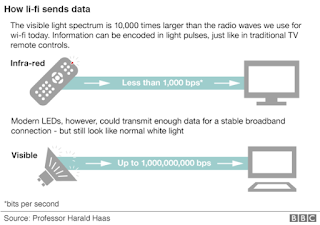A new and faster method of delivery data where visible spectrum(light) is used instead regular radio waves used in Wi-Fi has been tested.
Li-Fi stands for light fidelity and can reach speeds of up to 1Gbps(one gigabit per second).
It requires a light source(such as a regular LED bulb), internet connection and a photo detector.
Li-Fi was tested last week by a company named velmenni, they used Li-Fi enabled LED lamps to transmit data at a speed of 1Gbps, laboratory tests showed speeds of up to 224Gbps.
It was tested in an office to allow workers access the internet and in an industrial space where it provided lighting solutions.
Chief Executive Deepak Solanki said the technology could reach consumers within three to four years.
The term 'Li-Fi' was coined by Prof. Harald Haas from Edinburg University, he demonstrated the technology at a T.E.D(Technology,Entertainment and Design) conference in 2011.
One of the main advantage of the new Li-Fi over Wi-Fi is the fact that it uses visible spectrum(light) instead of radio waves and as such can not interfere with radio signals and so it can be used on an aircraft and other place where radio waves are restricted such as a gas station.
Li-Fi delivers faster data than Wi-Fi but just like Wi-Fi, it depends on the initial potential speed being delivered, for example if your home internet service is capped at 1Gbps(gigabit per second), the Li-Fi system won't go any faster than that.
Li-Fi also depends on your device being within range of the light being transmitted, so you need to see the light to get the data.
The Li-Fi system requires that you be under the ray of light being emitted.
NOTE: The Li-Fi system is not looking to take over the internet transmission technologies already available(it is not taking our precious Wi-Fi away from us) but it is just looking to be a good addition to the ones already available.
Li-Fi stands for light fidelity and can reach speeds of up to 1Gbps(one gigabit per second).
It requires a light source(such as a regular LED bulb), internet connection and a photo detector.
Li-Fi was tested last week by a company named velmenni, they used Li-Fi enabled LED lamps to transmit data at a speed of 1Gbps, laboratory tests showed speeds of up to 224Gbps.
It was tested in an office to allow workers access the internet and in an industrial space where it provided lighting solutions.
Chief Executive Deepak Solanki said the technology could reach consumers within three to four years.
The term 'Li-Fi' was coined by Prof. Harald Haas from Edinburg University, he demonstrated the technology at a T.E.D(Technology,Entertainment and Design) conference in 2011.
One of the main advantage of the new Li-Fi over Wi-Fi is the fact that it uses visible spectrum(light) instead of radio waves and as such can not interfere with radio signals and so it can be used on an aircraft and other place where radio waves are restricted such as a gas station.
Li-Fi delivers faster data than Wi-Fi but just like Wi-Fi, it depends on the initial potential speed being delivered, for example if your home internet service is capped at 1Gbps(gigabit per second), the Li-Fi system won't go any faster than that.
Li-Fi also depends on your device being within range of the light being transmitted, so you need to see the light to get the data.
The Li-Fi system requires that you be under the ray of light being emitted.
NOTE: The Li-Fi system is not looking to take over the internet transmission technologies already available(it is not taking our precious Wi-Fi away from us) but it is just looking to be a good addition to the ones already available.










0 comments:
Drop your comments and share your thoughts...